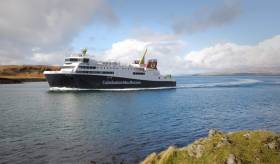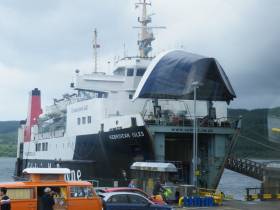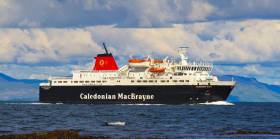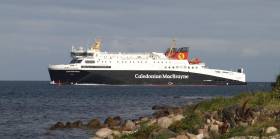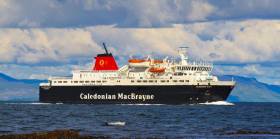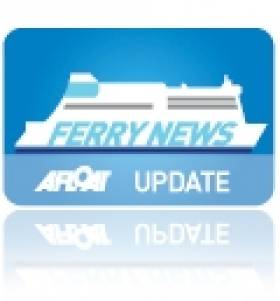Displaying items by tag: CalMac
Cast Your Vote: Name New Scottish Arran Dual-Fuel Ferry
#VoteFerryName - A public vote is underway to name the first of a pair of Scottish newbuilds for operator Caledonian MacBrayne. The 102m dual-fuel ferries are to serve Arran on the Forth of Clyde and south-west Scotland, writes Jehan Ashmore.
The pair costing £97m are currently under construction on the Clyde, are designed to provide a fully flexible year-round service for Arran and the Uig Triangle. This is subject to a final review by CalMac Ferries Ltd, Caledonian Maritime Assets Limited (CMAL) and Transport Scotland.
The first of the liquefied natural gas (LNG) and marine diesel fuelled ferries is expected to enter service in early 2018, with the sister following a few months later. Each ferry will carry 127 cars or 16 HGVs or a combination of both and up to 1,000 passengers. In terms of appearance the newbuilds like their existing counterparts will feature twin funnels, see related report.
On introduction they are to replace the oldest of CalMac’s larger ferries, Isle of Arran (see Afloat’s ferry voyage report) and regular island-serving ferry, Caledonian Isles. These ferries will be cascaded throughout the extensive network of 20 routes serving the Inner and Outer Hebrides, a region stretching some 200 miles from Arran to Lewis, makes CalMac the largest ferry operator in the UK.
Among the 32 strong fleet is the ‘Island’ class Canna, albeit on charter from CMAL to Rathlin Ferry Co. The ageing ferry dating to 1976 is soon to be replaced by newbuild Spirit of Rathlin.
Vote from the Shortlist
A shortlist has been selected by the (CMAL) Board and the Scottish Government with help from the Clyde River Steamer Club to reflect the ferry’s Scottish roots. The ferry, currently known as Hull 801, is earmarked for Arran and all names are inspired by the island history and geography.
Shortlisted names for the new ferry are:
Glen Sannox – one of three spectacular valleys on the island, but also the name of the first purpose-built car ferry that serviced the Isle of Arran
Goatfell – the highest point on Arran. On a clear day visitors can see as far as Ireland from its summit Hutton – the name of famous geologist, James Hutton who discovered his theory on the Isle of Arran
Glen Iorsa – the largest valley on the Isle of Arran; steeped in history and a great example of landscape shaped by glaciers
The naming competition (open also to those outside Scotland) was launched recently. To vote in the competition simply go online here and vote for your preferred choice before midnight on Monday 29th May 2017, when voting closes.
The name with the most public votes will be the name of the first LNG ferry.
All of those who voted for the winning name will be entered into a prize draw. One person chosen at random will be invited as a special guest (with a friend) to the launch of the ferry at Ferguson Marine Engineering Limited’s (FMEL) ship yard in Port Glasgow.
The winner will also receive a £200 gift voucher for the Auchrannie Resort, two bottles of commemorative whisky, bottled by Arran Distillery to mark this special occasion, and a special goody bag. Terms and conditions apply.
Please share this with colleagues, friends and family and encourage them to get involved and vote for their favourite name.
To find out more about the 102m dual fuel ferries project visit here.
#Aran&Arran – A passenger freightship that served the Aran Islands notably from Galway and a present day car ferry running to Arran, Scotland have similarities, writes Jehan Ashmore.
The custom-built Oileáin Árann (see photo) completed in 1991 at James Miller of St. Monans, on the Firth of Fife, served the Galway-Aran Islands route. The 416 gross tonnage vessel became the last ship to offer a 'direct passenger route' to and from the mid-west city, previously run by CIE’s Naomh Éanna.
Operator, O’Brien Shipping as previously reported sold the almost 40m long Oileáin Árann in 2006 to Icelandic owners Samskip. They converted the small ship to emerge as the ro-ro ferry Sæfari that trades in coastal waters to islands in northern Iceland.
As for the current car ferry operating to Arran, on the Firth of Clyde, the also custom-built Isle of Arran was too built in Scotland but on Clydeside at Ferguson Ailsa Ltd, Port Glasgow. The 3,296 gross tonnage relief ferry operates Ardrossan-Brodick (Arran: see Scotland in miniature) during the summer months. In addition Caledonian Isles operates year round for Caledonian MacBrayne (CalMac).
Towards the end of last month, the almost 85m Isle of Arran resumed seasonal Ardrossan-Campbeltown sailings on the Mull of Kintyre. This is the second year since the most southernmost CalMac route was given permanent status following a three year pilot trial. This was to develop traffic and boost tourism to the isolated peninsula a mere 11 nautical miles from Northern Ireland.
Likewise of the former Oileáin Árann, the CalMac pair feature twin funnels and have their names in Scots Gealic. Isle of Aran is translated to Eilean Arainn and as for Caledonian Isles this is Eileanan Chaledonia. The English names are displayed on the hull, while the bi-lingual versions are to seen on the superstructure.
Both these car ferries are to be replaced when the first of a pair of 102m dual-fuel (diesel and LPG) ferries are planned for year-round service for Arran and the Uig Triangle. Construction of the €97m newbuilds is taking place in Port Glasgow at the Ferguson Marine Engineering Limited’s (FMEL) shipyard. The design of these sleek looking newbuilds will again feature twin funnels.
The first newbuild is expected to enter service in early 2018, with the sister following a few months later. Each ferry will carry 127 cars or 16 HGVs or a combination of both and up to 1,000 passengers.
#KintyreService – Operator Caledonian MacBrayne (CalMac) during 2016 carried more than 5m passengers, began crossings mid-week on the seasonal Ardrossan-Campbeltown route, writes Jehan Ashmore.
Calmac the largest UK ferry operator achieved the 5m figure which was their busiest in more than two decades. A fleet of 32 serve a network of 20 routes stretching 200 miles from the Mull of Kintyre in the south and as far north to the Isle of Lewis, Outer Hebrides.
This will be the second year that Calmac are to operate the Kintyre service on a permanent basis following a three-year pilot period served by Isle of Arran. The 446 passenger, 68 car and 8 lorry capacity vessel returned to the route on Thursday. The southernmost route provides a tourist 'gateway' to the Kintyre Peninsula and a considerable saving on mileage.
In addition Isle of Arran, the oldest of the larger ferry fleet dating to 1984 and based out of Ardrossan is to boost capacity on the busier Forth of Clyde route to Arran. The Ardrossan-Brodick service is maintained year-round by Caledonian Isles that caters for 1,000 passengers, 120 cars and 10 lorries.
As previously reported on Afloat, Campeltown is also where the ‘passenger’ only Kintyre Express service began in Easter seasonal sailings too but to Northern Ireland using Ballycastle. These RIB craft operated crossings to and from the Antrim harbour are also where the Rathlin Ferry Co currently employ Canna, a former Calmac ferry.
The ‘Island’ class Canna dating to 1976, shares the route along with passenger only Rathlin Express, though the car ferry is to be replaced by newbuild Spirit of Rathlin. According to the operator's website, the new car ferry is expected to enter service in a couple of weeks.
CalMac to Redeploy Arran Ferry to Increase Islay Capacity
#ArranRedeployed - Scottish ferry operator, Caledonian MacBrayne is to redeploy a vessel from the Isle of Arran route to Islay and moving another to 24 hour working to increase capacity on the route.
The withdrawal of the Islay serving MV Hebridean Isles for urgent repairs reported last week here on Afloat.ie has left the Southern Hebrides island working with a single vessel over the last two weeks.
To ease disruption on the route, CalMac has now familiarised a new crew to operate the MV Finlaggan and the vessel will run an overnight freight service between Islay and Kennacraig, as well as her normal daytime timetable. Large vehicles such as caravans and camper vans will also be moved on to the overnight sailing to free up space during the day.
"We appreciate the inconvenience this ongoing disruption is causing and looked at all the options to address the issues the island is experiencing. This is particularly busy week,with the Islay Show taking place on Thursday, so we need to use the available fleet resources we have at our disposal to meet demand. Unfortunately, this means moving the the MV Isle of Arran off her normal Arran route. We realise this is not ideal, but hope the community on Arran understand the reasons behind this decision and we appreciate their cooperation," said CalMac's director of operations, Drew Collier.
"We feel this is the best solution we have to meet the demands we are currently experiencing across the network."
The MV Isle of Arran will sail the Kennacraig to Islay route begining from tomorrow, Tuesday and also Wednesday and Thursday of this week.
"We will be monitoring this on a daily basis and hopefully the redeployment of the Isle of Arran will be very short term only. Our technical team is working hard to get the Hebridean Isles back in service as quickly as possible and we appreciate people's patience and continuing understanding," added Drew.
Afloat adds while Isle of Arran is redeployed, her Arran fleetmate, M.V. Caledonian Isles will continue to operate sailings as normal on the Ardrossan-Brodick route
Disruption to Scottish Service As Ferry Collides With Pier
#Disruption - A Scottish ferry that serves the Southern Hebrides island of Islay had a collision with a pier on the mainland near the end of last month, writes Jehan Ashmore.
The incident involved CalMac’s Hebridean Isles at Kennacraig Pier, Kintyre, this led to the vessel been withdrawn from Islay (Port Ellen /Port Askaig) routes. Hebridean Isles, currently remains under repair with work to the bow, at the Garvel James Watt Dock, Greenock, on the Clyde, operated by the Forth Group.
Ferry services between Kennacraig-Islay have been reduced to one ferry operated by Finlaggan. The disruption during the high-season, has led to CalMac chartering a cargoship with vehicle bow-loading capability, the Red Princess.
To ease congestion, Red Princess, a former Mediterranean ferry, normally used to carry round timber, is been used to alleviate the backlog of vehicle traffic from Kennacraig to Islay and back while Hebridean Isles is being repaired.
Passengers will not be taken on the Red Princess, however they will be transferred to Finlaggen on the Kennacraig-Islay routes.
Other routes that Hebridean Isles served to the Southern Hebrides (including Colonsay) based out of Oban have been cancelled, however those booked are been transferred to alternative sailings.
Port Ellen, on the southern coast of Islay, is where Kintyre Express operate a service to Ballycastle, Co. Antrim as previously reported on Afloat.ie, see Port Snapshot: Campbeltown.
Scottish Arran Route First for New Mobility Access Trial
#FerryMobility – Caledonian MacBrayne (CalMac) ferries to the Isle of Arran on the Forth of Clyde are trialling a new booking system that should improve the travelling experience for passengers with mobility problems.
The operator is testing a new reservations procedure on the MV Caledonian Isles and the MV Isle of Arran that will prioritise car spaces for people who need access to the lift from the car to the passenger deck. Two car deck spaces have now been identified next to the lifts specifically for wheelchair users and passengers who have difficulty walking.
The project trial was devised by CalMac's Ardrossan port manager, Colin McCort and Customer Operations Support Manager, Rosalind Robertson.
"Currently, we do not have a system in place that allows us to prioritise people who have difficulty getting around. By designating specific car spaces those people will now be able to exit their vehicle directly into the lift that takes them to main deck. Sailing, by its nature, presents barriers to people with mobility issues but this is another small step toward improving the travelling experience for all our passenger whatever their needs," explained Rosalind.
Customers who need mobility assistance when booking on the Ardrossan-Brodick route should now book directly through Customer Contact Centre's freephone number 0800 066 5000 to reserve their space.
The North Ayrshire Access Panel was closely involved in the development of the new booking system.
"The panel members were pleased to be approached by Caledonian MacBrayne to assist in the development of this new system. This is a welcome improvement for passengers that need a bit more help when sailing. We look forward to continuing our work with CalMac on this and other projects," said Panel chairman, Peter Joyce.
The new system will also allow marshals to identify which vehicles are to be prioritised dockside and direct them to specific waiting spaces.
"After closely monitoring the success of this trial we can hopefully roll it out across the network for all vessels with lift access," added Rosalind.
#FerryBids - Final bids have been submitted writes STV News in the tendering process for the £1bn Clyde and Hebrides ferry services.
Publicly owned Calmac is competing with UK ferry firm Serco for the eight-year contract to operate ferries on 26 routes covering the west coast of Scotland. Both firms submitted initial tenders to the Scottish Government in December.
They were the only companies which applied to bid for the contract, despite the government extending the usual six-year deal to eight years.
West coast ferries are currently operated by Calmac but Serco won the contract for sailings to Shetland and Orkney in 2012. The west coast contract will be awarded in May 2016 and take effect in October. To read more, click here.
Afloat adds, CalMac's flagship Loch Seaforth (as pictured above) carried out sea trials in the Irish Sea and as far south off Wicklow Head in 2014.
Report Urges ‘Keep CalMac in Public Hands’
#KeepPublic - The Scotsman writes that an “overwhelming” case for keeping CalMac in public hands has been revealed in a new academic report, according to the Rail, Maritime and Transport (RMT) union, which commissioned the study.
Private-sector bidder Serco has been motivated to bid for the 26-route west coast ferry network (including Mull of Kintyre) as a “profit-seeking entity”, Glasgow University senior economics lecturer Jeanette Findlay said.
She found “much less evidence” that the firm would champion good working practices and customer service.
For more on the story surrounding the Scottish Government run ferry firm, click here.
Third Cutting Edge 'Hybrid' Ferry Launched on Clyde for CalMac
#ThirdHybrid - The third of three cutting edge 'hybrid' ferries MV Catriona, was launched on the Clyde this month at Ferguson Marine Engineering Ltd's (FMEL) shipyard in Port Glasgow. She is to serve the Scottish government-owned operator, CalMac.
The unique design of MV Catriona and her sisters are sea-going passenger and vehicle roll-on, roll-off ferries that incorporate a low-carbon hybrid system of traditional diesel power and electric lithium-ion battery power.
Her sister MV Hallaig, was the first in the world to incorporate this technology in a sea-going vessel when launched in December 2011. The innovative vessel was launched by Mrs. Anna Østergaard, wife of Caledonian Maritime Assets Ltd (CMAL) Chairman, Erik Østergaard.
MV Catriona is 43.5m long, accommodating 150 passengers, 23 cars or two HGVs and is owned by Caledonian Maritime Assets Limited (CMAL) and will be run by CalMac Ferries Ltd, the operator of the Clyde and Hebrides Ferry Service.
Sea trials are scheduled for spring 2016 (see Afloat report on MV Loch Seaforth) and the newbuild MV Catriona is to enter service following testing and certification.
Erik Østergaard, Chairman of Caledonian Maritime Assets Ltd commented: "We are very proud that the design and construction of this new class of ferry, using world class technology, was carried out in Scotland, continuing a proud tradition of shipbuilding on the Clyde.
"The launch of our three hybrid ferries - MV Hallaig, MV Lochinvar and MV Catriona - demonstrates CMAL's commitment to leading the way in innovative ferry design and our focus on creating new vessel technology. The technology is cleaner, quieter and cheaper to operate and maintain than ever before. Their introduction to our fleet demonstrates the vast economic potential of developing green technology within the transport industry."
The £12.3 million vessel is a further investment by the Scottish Government in CMAL's Clyde and Hebrides Ferry Service fleet and is the third commercial ship to be fully built and delivered on the Clyde in five years. This is the first ship built by Ferguson Marine Engineering Ltd (FMEL), who was awarded the contract in September 2014, following their purchase of the Ferguson Shipbuilders business. The previous two hybrid vessels were also built in the same yard.
The new ferries are designed to operate on many of the short crossing routes around the Clyde and Hebrides and the route for this ferry will be announced by CalMac Ferries Ltd early in 2016.
Transport and Islands Minister, Derek McKay, said: "The official launch of the MV Catriona marks a further milestone in our improvements to the fleet serving the Clyde and Hebrides network.
"Delivery of this third hybrid vessel not only underlines the Scottish Government's commitment to making our ferry fleet sustainable and reliable, but it also showcases the expertise on offer at the FMEL shipyard. The technology used on the new vessel will mean it will be fuel efficient and have lower maintenance costs, whilst still ensuring a quality service for passengers.
"The Scottish Government has invested a record £1 billion in vessels, ports and ferry services since 2007. With a £97 million order made for two new vessels for the fleet - also to be built at the FMEL yard on the Clyde - there will be further good news to come for our island communities.
"I congratulate all parties involved in the project and look forward to seeing the MV Catriona enter full service next year."
Liam Campbell, Managing Director, FMEL, added: "We would like to acknowledge our appreciation to both CMAL and the Scottish Government for placing the order for the latest hybrid vessels with FMEL last September. The build of MV Catriona was a welcome boost to us and, indeed, the Inverclyde Community."
Caledonian MacBrayne (CalMac) Managing Director, Martin Dorchester, said: "We look forward to welcoming this, the third vessel in this class, to our fleet and working with CMAL to get her in service as quickly as possible. The further adoption of hybrid technology reinforces CalMac's position as the UK's most innovative ferry operator."
The first hybrid ferry, the MV Hallaig, was launched in December 2011 and services the Sconser to Raasay route.
MV Lochinvar, the second hybrid ferry runs from Tarbert to Portavadie and launched in May 2013.
Their low-carbon hybrid system is leading to a reduction in fossil fuel consumption and carbon emissions.
Operational experience has shown, from analysis of MV Hallaig, that the hybrid vessels are capable of reducing fuel consumption by up to 38% compared to a conventionally powered vessel of the same size.
The reduction of fuel consumption will result in a decrease in CO2 emissions in excess of 5,500 tonnes per vessel over their lifetime with a proportionally similar decrease in sulphur and nitrogen oxide emissions.
New CalMac Ferry Is Visited by Scottish Transport Minister
#CalMacNewbuild - The newest Caledonian MacBrayne (CalMac) carferry, MV Loch Seaforth last week was paid a visit by Scottish Transport Minister Keith Brown MSP.
The new ferry fresh from German shipbuilders had arrived in Scottish waters only days before the visit and she joins the CalMac fleet which includes Isle of Aran.
As previously reported on Afloat.ie, Isle of Aran had operated the summer-only Campbeltown (Mull of Kintyre)-Ardrossan route which has been extended for a third season in 2015.
Mr Brown met the Master and crew and had a short private tour of the £41.8m newbuild which was built by Flensburger Schiffbau-Gesellschaft (FGS), while berthed in Inchgreen dry dock, Port Glasgow.
Mr Brown said: "I was delighted to get a chance to see the new MV Loch Seaforth up close and get a taste of what her passengers have to look forward to. The sight of the largest vessel in the CalMac fleet coming down the Clyde last week was a welcome one, and whilst some cosmetic work still has to be done to the interior of the ship, we are another step closer to seeing her enter service.
"The MV Loch Seaforth will offer passengers on the Stornoway-Ullapool route a faster, quieter and more reliable service and has been designed to accommodate a growth in travellers on the route.I look forward to the MV Loch Seaforth offering an improved service for the Western Isles, alongside the planned harbour upgrades at Stornoway and Ullapool."
There are a number of activities planned for her prior to entering service, including completing work on the passenger areas, addressing some outstanding technical matters from build, further Class & MCA inspections and carrying out sea trials and crew familiarisation exercises.
Martin Dorchester, Managing Director of CalMac, said: "Bringing the MV Loch Seaforth back to Scotland from the yard in Germany where she was built was an important milestone and once we are fully satisfied that everything is in order, and subject to the completion of the Stornoway Harbour works, will be making arrangements to take her to the Western Isles and, in due course, bring her into service on the Stornoway-Ullapool route."


























